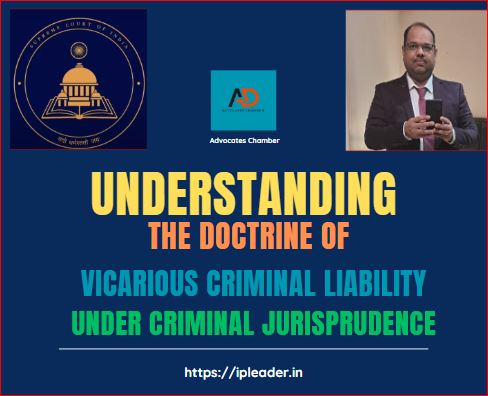Understanding the Doctrine of Vicarious Criminal Liability

Even If Fatal Injury Is Caused By Only One Member Of Unlawful Assembly, All Co-Accused Will Be Liable For Murder.
The Punjab & Haryana High Court has reiterated that even if the fatal injury was caused by one person of the unlawful assembly to the deceased, all will be liable for murder under the principle of “vicarious criminal liability”.
Justice Sureshwar Thakur and Sudeepti Sharma said, “Even if the lethal assault was caused by one of the accused, whereas, the other co-accused caused grievous injuries on the person of the injured. Nonetheless, each of the accused who formed an unlawful assembly, rather merely on the above score, qua the fatal injury becoming not caused by each of them, but becoming caused only by one of them, inasmuch as, the lethal injury becoming caused by convict Jasbir Singh, thus were not required to be saved from the attraction qua them vis-a-vis the principle of vicarious criminal liability, as enshrined in Section 149 of the IPC.”
The bench explained that all the accused, thus not only formed an unlawful assembly but also thereby they are deemed to be holding a “common object”.
It added that all the co-accused concerned, who were evidently members of an unlawful assembly, besides shared a common object, “thus with the principal accused, thereupon all the accused were also required to be convicted for a charge drawn for an offence punishable under Section 302 of the IPC, irrespective of the factum, that the fatal injury becoming not being caused by each of them, but becoming caused by only one of them, inasmuch as, the same becoming caused by Jasbir Singh (main accused).”
Facts in Brief
The case dates back to 1998, the accused Jasbir Singh gave some blows to the deceased and the main accused gave a fatal blow to the deceased.
After hearing the submissions and examining the submissions on record, the Court noted that the chain of circumstantial evidence were linked with each other.
The bench considered that the prosecution witnesses have identified the accused and the witnesses identified the accused without any prior test identification parade.
“Significantly, since the appellants have not been able to either ably deny their signatures as occur on the exhibits (supra) nor when they have been able to prove the apposite denial. Moreover, since they have also not been able to bring forth tangible evidence but suggestive that the recoveries are either contrived or invented. Therefore, all the exhibits are prima facie concluded to be holding the utmost evidentiary tenacity,” the bench said.
Furthermore, the Court highlighted that the “accused were not bystanders to the crime event thereupons, when they did evidently made incriminatory participations in the crime event, therebys thus reiteratedly all of them became vicariously liable for the offence of murder, as became committed by the principal accused and/or by the principal in the first degree, inasmuch as, by convict Jasbir Singh.”
Consequently, the Court allowed the appeal filed by the State and modified the conviction under Section 304-I IPC to Section 302 IPC.
Title: State of Punjab v. Jasbir Singh and others
